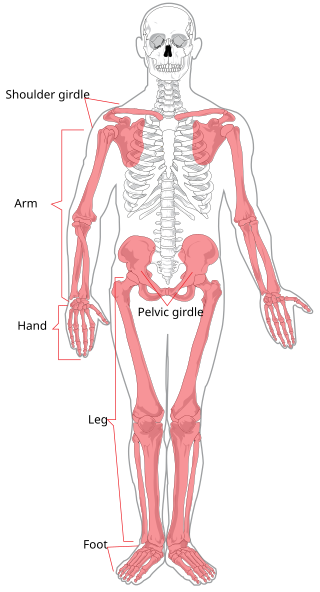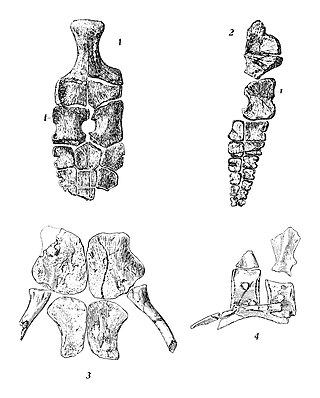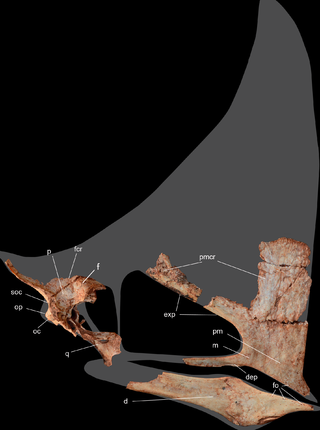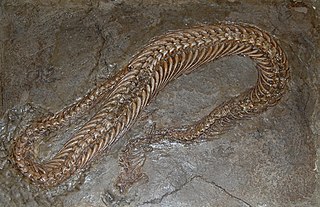
The appendicular skeleton is the portion of the vertebrate endoskeleton consisting of the bones and cartilages that support the paired appendages. In most terrestrial vertebrates, the appendicular skeleton and the associated skeletal muscles are the predominant locomotive structures.

Petrolacosaurus is an extinct genus of diapsid reptile from the late Carboniferous period. It was a small, 40-centimetre (16 in) long reptile, and one of the earliest known reptile with two temporal fenestrae. This means that it was at the base of Diapsida, the largest and most successful radiation of reptiles that would eventually include all modern reptile groups, as well as dinosaurs and other famous extinct reptiles such as plesiosaurs, ichthyosaurs, and pterosaurs. However, Petrolacosaurus itself was part of Araeoscelida, a short-lived early branch of the diapsid family tree which went extinct in the mid-Permian.

Pachyrhachis is an extinct genus of snake with well developed hind legs known from fossils discovered in Ein Yabrud, near Ramallah, in the central West Bank. It is a relatively small snake, measuring more than 1.5 metres (4.9 ft) long at maximum. Pachyrhachis appears to have been an ancient marine snake; the fossils occur in a marine limestone deposit, and the thickened bone of the ribs and vertebrae would have functioned as ballast to decrease the buoyancy of the animal, allowing it to dive beneath the ancient Cretaceous seas that it once inhabited.
Peloneustes is a genus of pliosaurid plesiosaur from the Middle Jurassic of England. Its remains are known from the Peterborough Member of the Oxford Clay Formation, which is Callovian in age. It was originally described as a species of Plesiosaurus by palaeontologist Harry Govier Seeley in 1869, before being given its own genus by naturalist Richard Lydekker in 1889. While many species have been assigned to Peloneustes, P. philarchus is currently the only one still considered valid, with the others moved to different genera, considered nomina dubia, or synonymised with P. philarchus. Some of the material formerly assigned to P. evansi have since been reassigned to "Pliosaurus" andrewsi. Peloneustes is known from many specimens, including some very complete material.

Askeptosaurus is an extinct genus of askeptosauroid, a marine reptile from the extinct order Thalattosauria. Askeptosaurus is known from several well-preserved fossils found in Middle Triassic marine strata in what is now Italy and Switzerland.
Casea is a genus of herbivorous caseid synapsids that lived during the late Lower Permian (Kungurian) in what is now Texas, United States. The genus is only represented by its type species, Casea broilii, named by Samuel Wendell Williston in 1910. The species is represented by a skull associated with a skeleton, a second skull, a partial skull with a better preserved dentition than that of the preceding skulls, and several incomplete postcranial skeletons. Three other Casea species were later erected, but these are considered today to be invalid or belonging to different genera. Casea was a small animal with a length of about 1.20 m and a weight of around 20 kg.
Orthosuchus is an extinct genus of crocodyliform that lived during the Early Jurassic, about 196 million years ago. It was first discovered in 1963 in the Red Beds Formation in the Qacha's Nek Province of Lesotho, southern Africa. The characteristics showed on its postcranial skeleton and the skull indicated that it is a crocodyliform. The finding is significant since some of the characteristics found on this specimen were believed to be absent until Jurassic.

Adriosaurus is an extinct genus of squamate which lived in what is now Slovenia and other parts of Europe during the Late Cretaceous. It was a small, snake-like reptile, with the type species Adriosaurus suessi measuring up to 30 cm (12 in) in length. Adriosaurus represents the first occurrence of vestigial limbs in fossil lizards, having lost its manus and forearm completely in order to elongate its axial skeleton. These unique anatomical features led to discussions of the evolutionary patterns of limb reduction in Squamata.

Mecistotrachelos is an extinct genus of gliding reptile from the Late Triassic of Virginia. It is generally interpreted as an archosauromorph, distantly related to crocodylians and dinosaurs. The type and only known species is M. apeoros. This specific name translates to "soaring longest neck", in reference to its gliding habits and long neck. This superficially lizard-like animal was able to spread its lengthened ribs and glide on wing-like membranes. Mecistotrachelos had a much longer neck than other gliding reptiles of the Triassic such as Icarosaurus and Kuehneosaurus. It was probably an arboreal insectivore.

Archaeorhynchus is a genus of beaked avialan stem-birds from the early Cretaceous period. A fossil of its only known species, Archaeorhynchus spathula, was first reported in 2005 by Zhou & Zhang to have been found in Yixian Formation rocks at Yixian, Liaoning province, China, showing a well-preserved and essentially complete skeleton. Two more complete specimens were found in Lower Cretaceous deposits of Jianchang, Liaoning, northeastern China, preserving new anatomical information. These deposits are 120 million years old, whereas the original specimen was 125 million years old, meaning the age range for this species is 125-120Ma.

Qianosuchus is an extinct genus of aquatic poposauroid archosaur from the middle Triassic (Anisian) Guanling Formation of Pan County, China. It is represented by two nearly complete skeletons and a crushed skull preserved in the limestone. Qianosuchus was at least 3 metres long, and had several skeletal adaptations which indicate a semi-marine lifestyle, similar to modern-day saltwater crocodiles. These adaptations have not been seen in any other archosaur from the Triassic.

Eupodophis is an extinct genus of snake from the Late Cretaceous period. It has two small hind legs and is considered a transitional form between Cretaceous lizards and limbless snakes. The feature, described as vestigial, was most likely useless to Eupodophis. The type species Eupodophis descouensi was named in 2000 and resides now in the paleontology section of the Mim Museum in Beirut, Lebanon. The specific name is dedicated to the French naturalist Didier Descouens.

Toretocnemus is an extinct genus of ichthyosaur. Its remains have been found in California, United States, in Triassic layers of the Carnian Hosselkus Limestone.

Fodonyx is an extinct genus of rhynchosaur from the middle Triassic epoch of Devon in England. Its fossils were discovered in Otter Sandstone Formation and were first assigned to Rhynchosaurus spenceri. This species was reassigned to its own genus, Fodonyx the holotype of which is EXEMS 60/1985/292, that described by David W. E. Hone and Michael J. Benton in 2008. In 2010, one skull was reassigned to the new genus Bentonyx. It is distinguished from other rhynchosaurs by a single autapomorphy, the ventral angling of the paraoccipital processes. In all other rhynchosaurs these processes angle dorsally or are horizontal. It is not known if this conferred any advantage to Fodonyx. Fodonyx was between 40 and 50 cm long.

Diandongosuchus is an extinct genus of archosauriform reptile, possibly a member of the Phytosauria, known from the Middle Triassic of China. The type species Diandongosuchus fuyuanensis was named in 2012 from the Zhuganpo Formation of Yunnan Province. It is a marine species that shows similarities with another Chinese Triassic species called Qianosuchus mixtus, although it has fewer adaptations toward marine life. It was originally classified as the basal-most member of the pseudosuchian clade Poposauroidea. However, a subsequent study conducted by Stocker et al. indicated it to be the basalmost known phytosaur instead.

Caiuajara is an extinct genus of tapejarid pterosaur from the Early Cretaceous period of Brazil. It is known from a single type species, Caiuajara dobruskii.
Panguraptor is a genus of coelophysid theropod dinosaur known from fossils discovered in Lower Jurassic rocks of southern China. The type and only known species is Panguraptor lufengensis. The generic name refers to the deity Pangu but also to the supercontinent Pangaea for which in a geological context the same characters are used: 盘古. Raptor means "seizer", "robber" in Latin. The specific name is a reference to the Lufeng Formation. The holotype specimen was recovered on 12 October 2007 from the Lufeng Formation of Yunnan, which is noted for sauropodomorph fossils. It was described in 2014 by You Hai-Lu and colleagues.

Pachyophis is an extinct genus of Simoliophiidae snakes that were extant during the Cenomanian stage of the Late Cretaceous period. More specifically, it was found to be from the Cenomanian Age about 93.9-100.5 million years ago in the suburb area of Bileca, Herzegovina.

Cabarzia is an extinct genus of varanopid from the Early Permian of Germany. It contains only a single species, Cabarzia trostheidei, which is based on a well-preserved skeleton found in red beds of the Goldlauter Formation. Cabarzia shared many similarities with Mesenosaurus romeri, although it did retain some differences, such as more curved claws, a wide ulnare, and muscle scars on its sacral ribs. With long, slender hindlimbs, a narrow body, an elongated tail, and short, thick forelimbs, Cabarzia was likely capable of running bipedally to escape from predators, a behavior shared by some modern lizards. It is the oldest animal known to have adaptations for bipedal locomotion, predating Eudibamus, a bipedal bolosaurid parareptile from the slightly younger Tambach Formation.

Alpkarakush is an extinct genus of metriacanthosaurid theropod dinosaurs from the Jurassic Balabansai Formation of Kyrgyzstan. The genus contains a single species, A. kyrgyzicus, known from a partial skeleton.















